Understanding barriers to diabetes eye screening in a large rural general practice: an audit of patients not reached by screening services
Angel Harbers 1 , Scott Davidson 2 3 * , Kyle Eggleton
2 3 * , Kyle Eggleton  2
2
1 Faculty of Medical and Health Sciences, The University of Auckland, Auckland, New Zealand.
2 Department General Practice and Primary Health Care, Faculty of Medical and Health Sciences, The University of Auckland, Auckland, New Zealand.
3 Dargaville Medical Centre, Dargaville, Northland, New Zealand.
Journal of Primary Health Care 14(3) 273-279 https://doi.org/10.1071/HC22062
Published: 30 September 2022
© 2022 The Author(s) (or their employer(s)). Published by CSIRO Publishing on behalf of The Royal New Zealand College of General Practitioners. This is an open access article distributed under the Creative Commons Attribution-NonCommercial-NoDerivatives 4.0 International License (CC BY-NC-ND)
Abstract
Introduction: Diabetes is a leading cause of blindness in New Zealanders, yet a significant proportion of patients with diabetes are not reached by diabetes eye screening.
Aim: Our study audited patients with diabetes in a large New Zealand rural general practice, to identify addressable barriers preventing patients from attending diabetes eye screening.
Methods: All patients who had missed a diabetes eye screening appointment at the Dargaville Hospital Eye Screening Clinic between 2018 and 2021 were identified. Demographic information, laboratory and disease status data were recorded and analysed. Semi-structured telephone interviews were undertaken with 66 patients exploring barriers to diabetes eye screening. Descriptive statistical analysis was performed on quantitative data and a thematic analysis on qualitative results.
Results: One-hundred and fifty-four (27%) of 571 patients invited to screening missed at least one appointment; of these, 66 (43%) were interviewed. Quantitative analysis suggested Māori patients were less likely to be reached, with a 20% higher number of missed appointments than European patients and a higher glycated haemoglobin (HbA1c). Māori patients reported greater barriers to attending eye screening. Common barriers identified by participants were transport, work and family commitments, financial, health and lack of appointment reminders.
Discussion: Increased barriers for Māori patients could explain the reduced ability of the screening service to reach Māori patients. In order to address inequity and increase overall screening rates, diabetes eye screening and primary care services need to improve the booking system, facilitate transport to screening, engage patients and their whānau and build trust.
Keywords: barriers, diabetes, diabetic retinopathy, inequity, Māori, non-attendance, rural, screening.
| WHAT GAP THIS FILLS |
| What is already known: Screening patients with diabetes for retinopathy is an important first step in preventing blindness; however, a significant proportion of patients are not being reached by screening services. |
| What this study adds: Common barriers reported to screening were lack of direction to be screened by GPs and nurses, transport, work, family, cost, health and difficulties with the appointments system. Māori patients who were not reached by screening reported 2.8-fold the number of barriers than European patients. |
Introduction
Screening for diabetic eye disease has the ability to find early and treatable retinopathy and significantly reduce blindness.1 Reaching patients with eye screening is therefore an important first step in preventing visual loss for patients and reducing the burden of blindness. Although multiple barriers to diabetes care exist,2,3 there are few New Zealand (NZ) studies examining the reasons why patients are unable to attend retinal screening appointments.4–6 Within this study, we present findings from the first component of a quality improvement project in a large rural general practice that describe the barriers that many patients face; transport, co-morbidity, family priorities, cost, direction from health professionals and the appointments system.4,7,8
General practice is the primary deliverer of care to patients with diabetes and plays an important role in ensuring onward referral for management of diabetic complications to secondary care.9 One specific complication is diabetic retinopathy (DR), a microvascular disease that causes progressive damage to the retina. Diabetic retinopathy is common, with up to 20–25% of people with type two diabetes mellitus having retinopathy.10 It is also the leading cause of blindness and loss of sight in New Zealanders aged <50 years.11
Screening, through retinal photographs or dilated pupil fundus examination with a slit-lamp, and early treatment of DR, have been shown to be effective at decreasing the risk of blindness.12,13 Retinal screening in NZ has been the responsibility of District Health Boards (DHB), with local models of delivery and overarching national standards.10 Typically, each DHB would have a central co-ordinator who receives and processes general practice referrals, organises screening appointments and refers to ophthalmology services for assessment and management.10 Screening occurs every 3 years, or more frequently depending on clinical modifiers and retinopathy grading.10 Non-attendance of these screening appointments can lead to adverse outcomes for patients.14
Although screening is an essential measure, non-attendance rates in New Zealand remains high, ranging from 27.3 to 36.4%, with high-risk groups such as Māori, Pacific people and young adults having even lower attendance.15 Previous studies completed in Waikato and South Auckland identified barriers to general diabetes treatment, some of which include confusion around screening times, other co-morbidities altering ability to attend, knowledge about the disease and screening, transportation and competing time commitments.4 For Māori, Pacific people and people living rurally, multiple barriers to receiving diabetes care often exist.4,8,16,17 However, most studies on eye screening non-attendance are overseas based and may not reflect the NZ population and specific barriers in relation to the NZ context.2,3,8 In addition, there is limited qualitative literature involving patients who have been unable to attend retinal screening. Interviewing patients who have not attended their diabetic retinal screening may identify barriers that these patients face and allow for a better understanding of how to overcome them.
Methods
Setting
The Northland District Health Board (NDHB) has approximately 193 170 people in its catchment region, with 12 025 people with diabetes (6.2%) (2020–21).18 Dargaville Medical Centre (DMC) is a single large rural group general practice in NDHB’s western Kaipara area, based at the Dargaville Hospital Campus, with approximately 12 159 enrolled patients (European 62.2%, Māori 31.4%, Pacific 2.6%). Six-hundred and eighty-nine (European 60%, Māori 34%, Pacific 3%, Asian 2%) patients at DMC are coded with diabetes (5.6%). NDHB’s retinal screening service runs a mobile screening service to Northland rural areas, one of which is based at Dargaville Hospital, with the register and wider service team based at Whangarei Hospital. Reminders are sent via phone call, text message or letter. If a patient misses their first appointment, another is sent out a few weeks later, and if that appointment is missed, they receive an appointment in the next screening cycle. If patients fail to attend multiple times, they are dropped from the recall list, but not removed from the register. They are advised they must call the register to be re-invited when they are able to attend.
The first author is a Māori medical student undertaking a summer studentship at DMC. The second author is a NZ European GP at DMC and a medical officer in the ophthalmology department at Whangarei Hospital and the third author is a NZ European GP. The study is the first part of a quality improvement project undertaken at DMC that involved three phases – audit of patients; telephone questionnaire development; and delivery and development of themes to explain barriers. The questionnaire was informed through a literature review of Medline Ovid searching for non-attendance diabetic retinal screening, New Zealand papers on diabetes and retinal screening, and barriers to diabetes care and retinal screening. From an analysis of these papers, a questionnaire with a patient-centred structure19 was developed and reviewed with secondary and primary care diabetes nurses and trialled with two diabetes patients. The questionnaire was refined, reviewed and finalised by the first two authors.
Participants and recruitment
Screening attendance data for DMC patients was sourced from the NDHB diabetes eye screening database after receiving approval from the NDHB designated ophthalmologist and screening coordinator. Between January 2018 and September 2021, the service invited 571 DMC patients to diabetes eye screening; 154 people missed at least one appointment during that period and were eligible to participate.
Participant recruitment and exclusion criteria are outlined in Fig. 1. Participants were telephoned and given a brief explanation of the study, verbally consented and completed the questionnaire. Each patient was called back on a different date if the first attempt to contact them was unsuccessful. The calls took place between December 2021 and January 2022, and call times ranged from 5 to 30 min long.
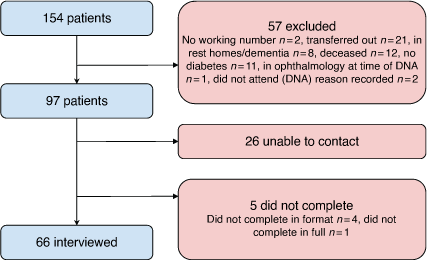
|
Analysis
Data on age, gender, ethnicity (Table 1), most recent HbA1c and latest eye screening results for participants were collected from the DMC patient management database (Table 2, Figs 2–4). The patient responses were recorded as yes or no, and any additional comments were noted (Table 3). A mixed methods approach was taken in which qualitative data were collected in order to inform the findings of the quantitative data. Qualitative data were the participants’ additional comments. These comments were recorded verbatim with notes, anonymised and then coded by the lead author. The codes were then categorised by the lead author and reviewed by the third author. Major themes were identified through inductive analysis,20 then reviewed and agreed upon by all three authors. T-tests were used to compare the mean HbA1c, gender, age and number of missed appointments between participant ethnicities, with European as the baseline for comparison. Pearson chi-squared and Fisher’s exact tests were used to compare the questionnaire responses for European, Māori and Pacific patients.
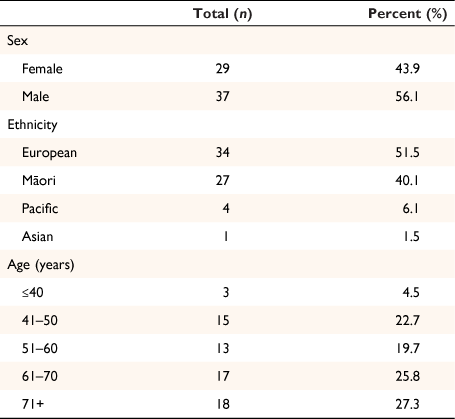
|

|

|
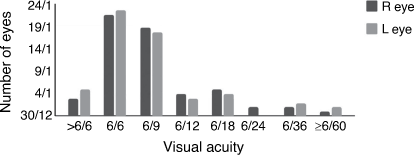
|
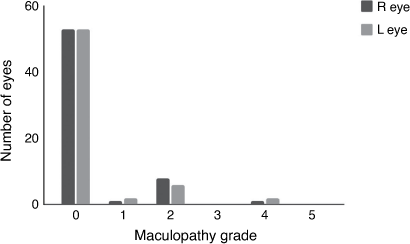
|
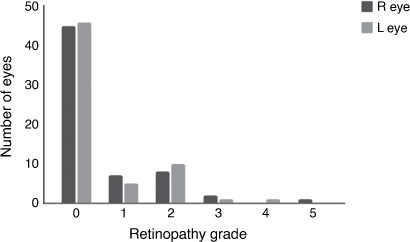
|
Health and Disability Ethics Committee processes were followed and the quality improvement project was deemed a low risk observational study and therefore did not require formal ethics approval.21
Results
Quantitative data
Twenty-seven percent (154) of 571 patients invited to screening missed at least one appointment and of these patients, 43% (66) completed a telephone interview in full. Two of the 66 patients had no visual acuity (VA) recorded. Seventeen of 128 eyes had worse than 6/12 vision and five patients had both eyes worse than 6/12 at their last recorded VA. Five patients had referable disease at their last recorded screen, with five eyes in three patients having R3 or worse retinopathy and three eyes in two patients having worse than M3 maculopathy (Figs 2–4). Asian ethnicity was excluded from analysis in Table 2 due to low numbers.
Qualitative data
Failure of the appointment system
There are failures in the appointment system, with some patients not receiving reminders or not receiving adequate notice of appointments and sometimes forgetting appointments ‘If you send the reminder too early you can forget’ (#27). Patients used a variety of modalities to contact the screening centre. Although some contacted the clinic directly, others would rely on the diabetes nurse, family or would ring the medical centre and did not mention contacting the screening clinic directly (eg ‘I usually go through the diabetes nurse to do it for me’ (#9); ‘Problem with eyes, need someone else to read it’ (#48)).
Multiple barriers to access
There are multiple barriers to access. Work was a common barrier mentioned (ie appointments being held at a time that the patient was working and the screening clinic having limited flexibility in altering appointments; ‘Not sure where I’ll be working at the time, so might not be able to get back for appointments’ (#27). There were financial barriers to travelling to the clinic – petrol costs and the distance some had to travel;‘Financial is the main barrier, biggest issue for low-income people’ (#61). A common barrier was having other health issues, which either limited mobility or vision or general health making it difficult to get to appointments; ‘I can’t walk long enough to get there, I have end-stage heart failure’ (#10). Finally, family priorities made it difficult for some, such as illness of family members or having tangi; ‘Was looking after someone that was dying, so skipped that appointment’ (#46).
Despite non-attendance, it appeared that knowledge of diabetic eye disease was not a significant barrier, with patients emphasising the importance of glucose management and diabetes management; ‘Need to maintain acceptable levels so the back of your eyes doesn’t get damaged’ (#75). However, some patients had differing levels of knowledge of diabetes and some confused different eye diseases, such as cataracts; ‘If your diabetes is out of control, it can cause glaucoma and cataracts’ (#38).
Previous interactions alter trust in the health system
Although some patients reported positive experiences from healthcare providers and received health education from healthcare providers, others had negative experiences and general distrust in the healthcare system. Rude staff, limited GP interactions, feeling that healthcare providers did not care were mentioned; ‘The lady that does it is quite harsh and abrupt, she growls me heaps’ (#45). Patients reported mistrusting the health system and not believing in treatments or Western medicine; ‘Go the pakeha way, and they’ll sit and kill the people by not listening to them… You never get to know the patients, until it’s kanohi ki te kanohi, eye to eye’ (#23).
Discussion
Our study in a large Northland rural general practice suggested Māori were more likely to miss an eye screening appointment, and they had a statistically significant higher number of barriers to screening compared to European patients. A lack of trust in the healthcare system, difficulties with appointments and several additional barriers to access were the major issues that we found. A recent Cochrane review of interventions to increase attendance for retinal screening concluded that quality improvement targeting patients, healthcare professionals or the healthcare system show meaningful improvements in retinal screening attendance compared to usual care,22 making these areas important to address.
There has been improvement in reaching diabetic patients for eye screening in Northland, with reported non-attendance rates dropping from 30% in 2012 to 22% in 2021.17,23 Northland’s population remains at high risk for referable diabetic maculopathy and retinopathy, with Māori and Pacific patients failing to be reached, resulting in lower attendance.17,23,24
We could find few published qualitative New Zealand studies looking at barriers to attendance in diabetic retinal screening. O’Grady et al. reported an audit of a small Northland rural community diabetes support group, which met weekly and was run by patients and their families, with Māori sovereignty acknowledged. Along with retinal screening, podiatry, nursing, dietitian and GP consultations were provided at no cost. An exercise program and food were provided. Although from a low base, improvement in retinal screening rates, lipids, HbA1c and other measures were reported over a 3-year period.5
A systematic review of qualitative retinal screening literature found cultural competency to be a facilitator to screening.2 Baxter, in a literature review on barriers to health care for Māori with known diabetes, outlines the cultural appropriateness of services with the importance of communication and understanding of cultural values, beliefs and practices, with possible facilitators to diabetes care being community empowerment, marae-based clinics and education.6 Māori Health inequities in diabetic retinopathy are well known in Northland.24 Although numerous explanations have been postulated, it is important to note that Europeans are significantly less likely to report giving priority to others needs over their own compared to Māori, and that this might impact on health clinic attendance, as reflected by comments from participants in this study.4,6 In our study, a low number of patients were offended by critical comments made by screening staff, and this might impact on trust in the service. Poor cultural safety has been reported as an issue in a systematic review of diabetic retinopathy screening literature.2
A number of studies have also reported trust in direction given by a healthcare professional to have a retinal screening, as a facilitator.3,25,26 Although GPs are generally trusted by their patients, they have reported time pressures as a barrier to referral for retinopathy screening.27 In our audit, just over half of patients reported they had been encouraged to attend screening by a GP or nurse.
Appointment system failure appeared as a theme on inductive analysis of patient comments. A diabetes annual check nurse-led clinic audit in an urban setting found the most frequent reason for non-attendance was being unaware, forgetting or being confused about the appointment time.28 We found that one-fifth of patients reported not receiving an invitation; this may well be related to poor cell phone coverage, rural mail issues, a mobile population and family living arrangements. Other studies have reported similar invitation failure rates.29 In our study, a significant number of patients were not contactable by two phone calls on different days and times. In discussion with the register administrator, we found that the register operates separately from the NDHB database and is unable to update patient contact details including phone numbers automatically. Potential solutions in improving the system would include improvement of rural cell phone services, multiple mode-repeated invitation messaging with notification to concerned health providers involved in the patient’s care; and pre-clinic contact and regular automated and integrated contact detail updates of the retinal screening database. Other solutions include management protocols for notifications, including non-attendance, to all healthcare providers involved. A more flexible and interactive appointments system is also recommended that enables patients, their whānau or the wider healthcare team, to organise suitable appointment times, to manage work and financial attendance barriers and other priorities preventing attendance.
Knowledge of retinopathy screening and risk of blindness in patients with diabetes has been reported as a factor in attendance, with some studies calling for more education of patients and their families.2,25,26,29 In our audit, the majority of patients understood diabetes could affect vision, but only a minority knew the available treatments. Poor vision, mobility and co-morbidities have also been reported as barriers.26,29 A number of patients in our audit had less than legal driving requirement acuity, likely making them reliant on others for transport. Additionally, financial barriers were reported as an issue, such as not having money or a vehicle for transport. This finding is in contrast to recent research suggesting that socioeconomic status is not a risk factor for non-attendance in the Northland population.17
Strengths of our study were high and representative response rates to the survey and the ability to review the patient’s medical record as the first two authors were part of the primary care team. The use of a mixed method approach provided deeper insight into the barriers that patients face. Limitations were that we surveyed a single rural practice population that may limit generalisation of results to other NZ general practices where variations in the system of screening delivery exist.9,10
Conclusion
Our study found three themes to be addressed to improve screening rates: the appointment system, barriers, and trust in the healthcare system. Similar themes were found in a systematic review of diabetic retinopathy screening.3 Māori reported significantly more barriers to screening. A multidisciplinary approach in education, support and system improvement is required to ensure efficient and uniform eye screening service delivery to patients. Improvements could be made in widening capacity, accessibility and flexibility of the appointments system, building trust through empathy, courtesy and cultural competence of healthcare workers, communication between primary care and screening services, and addressing access barriers. A health navigator or kaiāwhina could be a key worker in facilitating eye screening and overcoming barriers.
Data availability
The data from the study may be available by correspondence with the authors.
Conflicts of interest
The authors declare that they have no conflicts of interest.
Declaration of funding
The New Zealand Rural GP Network and the New Zealand Institute of Rural Health provided funding for this study.
Acknowledgements
The authors are grateful to Dr David Dalziel, Dr Laura Wolpert, Dot Johnson and Tracey Henderson (Diabetes Clinical nurse specialists), Brian Vickers (Medical Photographer) and Maree Nicholas (screening administrator) for their assistance with this study.
References
[1] New Zealand National Diabetes Retinopathy Steering Group. National Diabetes Retinal Screening Grading System and Referral Guidelines 2006. Wellington: New Zealand Ministry of Health; 2008.[2] Egunsola O, Dowsett LE, Diaz R, et al. Diabetic retinopathy screening: a systematic review of qualitative literature. Can J Diabetes 2021; 45 725–33.e12.
| Diabetic retinopathy screening: a systematic review of qualitative literature.Crossref | GoogleScholarGoogle Scholar |
[3] Kashim RM, Newton P, Ojo O. Diabetic retinopathy screening: A systematic review on patients’ non-attendance. Int J Environ Res Public Health 2018; 15 157
| Diabetic retinopathy screening: A systematic review on patients’ non-attendance.Crossref | GoogleScholarGoogle Scholar |
[4] Simmons D, Weblemoe T, Voyle J, et al. Personal barriers to diabetes care: lessons from a multi‐ethnic community in New Zealand. Diabet Med 1998; 15 958–64.
| Personal barriers to diabetes care: lessons from a multi‐ethnic community in New Zealand.Crossref | GoogleScholarGoogle Scholar |
[5] O’Grady A, Simmons D, Tupe S, et al. Effectiveness of changes in the delivery of diabetes care in a rural community. Aust J Rural Health 2001; 9 75–9.
| Effectiveness of changes in the delivery of diabetes care in a rural community.Crossref | GoogleScholarGoogle Scholar |
[6] Baxter J. Barriers to health care for Māori with known diabetes: a literature review and summary of the issues. Te Roopu Rangahau Hauora a Ngai Tahu; 2002.
[7] Lake AJ, Browne JL, Rees G, et al. What factors influence uptake of retinal screening among young adults with type 2 diabetes? A qualitative study informed by the theoretical domains framework. J Diabetes Complications 2017; 31 997–1006.
| What factors influence uptake of retinal screening among young adults with type 2 diabetes? A qualitative study informed by the theoretical domains framework.Crossref | GoogleScholarGoogle Scholar |
[8] Liu Y, Zupan NJ, Shiyanbola OO, et al. Factors influencing patient adherence with diabetic eye screening in rural communities: a qualitative study. PLoS One 2018; 13 e0206742
| Factors influencing patient adherence with diabetic eye screening in rural communities: a qualitative study.Crossref | GoogleScholarGoogle Scholar |
[9] Screening for diabetic retinopathy in primary care. BPJ 2010; 38–50. Available at https://bpac.org.nz/bpj/2010/august/retinopathy.aspx#:~:text=and%20prompt%20treatment-,Retinal%20screening%20should%20be%20carried%20out%20at%20least%20every%20two,degree%20of%20pre%2Dexisting%20retinopathy [Accessed 8 April 2022]
[10] Ministry of Health. Diabetic Retinal Screening, Grading, Monitoring and Referral Guidance. Wellington, New Zealand: Ministry of Health; 2016.
[11] The Blind Foundation New Zealand. Blindness and Low Vision in New Zealand-Information Statistics and Research. New Zealand. 2022. Available at https://blindlowvision.org.nz/information/statistics-and-research/ [Accessed 31 January 2022]
[12] Ferris FL, Davis MD, Aiello LM. Treatment of diabetic retinopathy. N Engl J Med 1999; 341 667–78.
| Treatment of diabetic retinopathy.Crossref | GoogleScholarGoogle Scholar |
[13] Virgili G, Parravano M, Menchini F, et al. Anti‐vascular endothelial growth factor for diabetic macular oedema. Cochrane Database Syst Rev 2014; Art. No.: CD007419
| Anti‐vascular endothelial growth factor for diabetic macular oedema.Crossref | GoogleScholarGoogle Scholar |
[14] Forster AS, Forbes A, Dodhia H, et al. Non-attendance at diabetic eye screening and risk of sight-threatening diabetic retinopathy: a population-based cohort study. Diabetologia 2013; 56 2187–93.
| Non-attendance at diabetic eye screening and risk of sight-threatening diabetic retinopathy: a population-based cohort study.Crossref | GoogleScholarGoogle Scholar |
[15] Ramke J, Jordan V, Vincent AL, et al. Diabetic eye disease and screening attendance by ethnicity in New Zealand: a systematic review. Clin Exp Ophthalmol 2019; 47 937–47.
| Diabetic eye disease and screening attendance by ethnicity in New Zealand: a systematic review.Crossref | GoogleScholarGoogle Scholar |
[16] Fearnley D, Kerse N, Nixon G. The price of ‘free’. Quantifying the costs incurred by rural residents attending publically funded outpatient clinics in rural and base hospitals. J Prim Health Care 2016; 8 204–9.
| The price of ‘free’. Quantifying the costs incurred by rural residents attending publically funded outpatient clinics in rural and base hospitals.Crossref | GoogleScholarGoogle Scholar |
[17] Wolpert LE, Sadler CH, Dalziel DM. Non-attendance at diabetic retinal screening in Northland, New Zealand. Clin Exp Ophthalmol 2022; 49 895–6.
[18] New Zealand Ministry of Health. NZ Health system. 2021. Available at https://www.health.govt.nz/new-zealand-health-system/my-dhb/northland-dhb/population-northland-dhb#:~:text=Northland%20District%20Health%20Board%20serves,older%20than%20the%20national%20average [Accessed 31 January 2022]
[19] Janes R, Titchener J. Viewpoint: using the patient-centred medicine clinical framework to better appreciate and explore the many barriers to care in Type 2 diabetes. J Prim Health Care 2014; 6 340–8.
| Viewpoint: using the patient-centred medicine clinical framework to better appreciate and explore the many barriers to care in Type 2 diabetes.Crossref | GoogleScholarGoogle Scholar |
[20] Braun V, Clarke V. Using thematic analysis in psychology. Qual Res Psychol 2006; 3 77–101.
| Using thematic analysis in psychology.Crossref | GoogleScholarGoogle Scholar |
[21] New Zealand Ministry of Health. Standard Operating Procedures for Health and Disability Ethics Committees, version 3.0 (Dec 2019). Wellington New Zealand; 2014. Available at https://ethics.health.govt.nz/operating-procedures [Accessed 1 November 2021]
[22] Lawrenson JG, Graham-Rowe E, Lorencatto F, et al. Interventions to increase attendance for diabetic retinopathy screening. Cochrane Database Syst Rev 2018; Art. No.: CD012054
| Interventions to increase attendance for diabetic retinopathy screening.Crossref | GoogleScholarGoogle Scholar |
[23] Papali’i-Curtin AT, Dalziel DM. Prevalence of diabetic retinopathy and maculopathy in Northland, New Zealand: 2011–2012. N Z Med J 2013; 126 20–8.
[24] Jagadish P, Dalziel D. Discharge outcomes of patients referred to specialist eye clinic from diabetic retinopathy screening in Northland (2014-15). N Z Med J 2017; 130 89–93.
[25] Fairless E, Nwanyanwu K. Barriers to and facilitators of diabetic retinopathy screening utilization in a high-risk population. J Racial Ethn Health Disparities 2019; 6 1244–9.
| Barriers to and facilitators of diabetic retinopathy screening utilization in a high-risk population.Crossref | GoogleScholarGoogle Scholar |
[26] Graham-Rowe E, Lorencatto F, Lawrenson JG, et al. Barriers to and enablers of diabetic retinopathy screening attendance: a systematic review of published and grey literature. Diabet Med 2018; 35 1308–19.
| Barriers to and enablers of diabetic retinopathy screening attendance: a systematic review of published and grey literature.Crossref | GoogleScholarGoogle Scholar |
[27] Bennett GH, Tuthill A. Investigating the barriers to the uptake of Diabetic Retina Screen. Ir Med J 2017; 110 628
[28] Wilkinson J, Daly M. Reasons for non-attendance: audit findings from a nurse-led clinic. J Prim Health Care 2012; 4 39–44.
| Reasons for non-attendance: audit findings from a nurse-led clinic.Crossref | GoogleScholarGoogle Scholar |
[29] Strutton R, Du Chemin A, Stratton IM, et al. System-level and patient-level explanations for non-attendance at diabetic retinopathy screening in Sutton and Merton (London, UK): a qualitative analysis of a service evaluation. BMJ Open 2016; 6 e010952
| System-level and patient-level explanations for non-attendance at diabetic retinopathy screening in Sutton and Merton (London, UK): a qualitative analysis of a service evaluation.Crossref | GoogleScholarGoogle Scholar |


